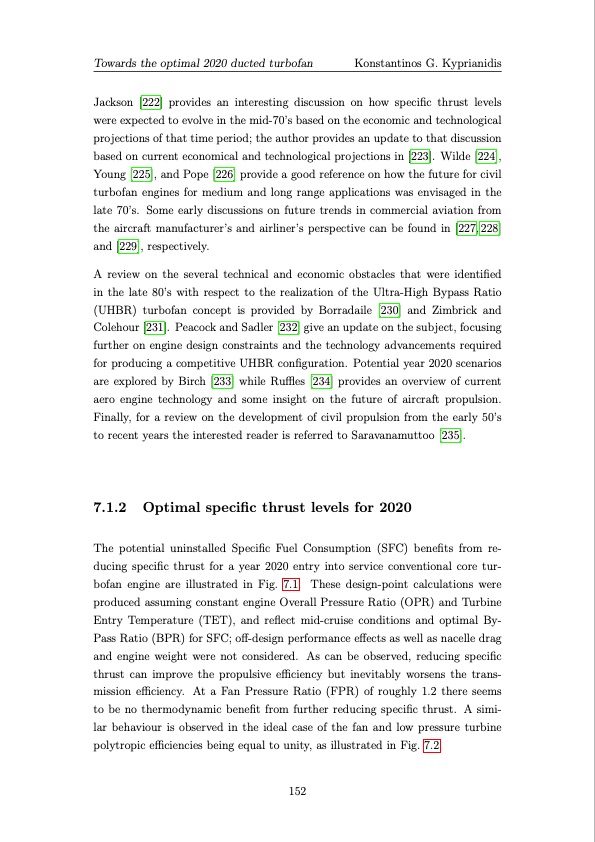
PDF Publication Title:
Text from PDF Page: 192
Towards the optimal 2020 ducted turbofan Konstantinos G. Kyprianidis Jackson [222] provides an interesting discussion on how specific thrust levels were expected to evolve in the mid-70’s based on the economic and technological projections of that time period; the author provides an update to that discussion based on current economical and technological projections in [223]. Wilde [224], Young [225], and Pope [226] provide a good reference on how the future for civil turbofan engines for medium and long range applications was envisaged in the late 70’s. Some early discussions on future trends in commercial aviation from the aircraft manufacturer’s and airliner’s perspective can be found in [227,228] and [229], respectively. A review on the several technical and economic obstacles that were identified in the late 80’s with respect to the realization of the Ultra-High Bypass Ratio (UHBR) turbofan concept is provided by Borradaile [230] and Zimbrick and Colehour [231]. Peacock and Sadler [232] give an update on the subject, focusing further on engine design constraints and the technology advancements required for producing a competitive UHBR configuration. Potential year 2020 scenarios are explored by Birch [233] while Ruffles [234] provides an overview of current aero engine technology and some insight on the future of aircraft propulsion. Finally, for a review on the development of civil propulsion from the early 50’s to recent years the interested reader is referred to Saravanamuttoo [235]. 7.1.2 Optimal specific thrust levels for 2020 The potential uninstalled Specific Fuel Consumption (SFC) benefits from re- ducing specific thrust for a year 2020 entry into service conventional core tur- bofan engine are illustrated in Fig. 7.1. These design-point calculations were produced assuming constant engine Overall Pressure Ratio (OPR) and Turbine Entry Temperature (TET), and reflect mid-cruise conditions and optimal By- Pass Ratio (BPR) for SFC; off-design performance effects as well as nacelle drag and engine weight were not considered. As can be observed, reducing specific thrust can improve the propulsive efficiency but inevitably worsens the trans- mission efficiency. At a Fan Pressure Ratio (FPR) of roughly 1.2 there seems to be no thermodynamic benefit from further reducing specific thrust. A simi- lar behaviour is observed in the ideal case of the fan and low pressure turbine polytropic efficiencies being equal to unity, as illustrated in Fig. 7.2. 152PDF Image | Multi-disciplinary conceptual design of future jet engine systems

PDF Search Title:
Multi-disciplinary conceptual design of future jet engine systemsOriginal File Name Searched:
thesis-future-jet-engines.pdfDIY PDF Search: Google It | Yahoo | Bing
NFT (Non Fungible Token): Buy our tech, design, development or system NFT and become part of our tech NFT network... More Info
IT XR Project Redstone NFT Available for Sale: NFT for high tech turbine design with one part 3D printed counter-rotating energy turbine. Be part of the future with this NFT. Can be bought and sold but only one design NFT exists. Royalties go to the developer (Infinity) to keep enhancing design and applications... More Info
Infinity Turbine IT XR Project Redstone Design: NFT for sale... NFT for high tech turbine design with one part 3D printed counter-rotating energy turbine. Includes all rights to this turbine design, including license for Fluid Handling Block I and II for the turbine assembly and housing. The NFT includes the blueprints (cad/cam), revenue streams, and all future development of the IT XR Project Redstone... More Info
Infinity Turbine ROT Radial Outflow Turbine 24 Design and Worldwide Rights: NFT for sale... NFT for the ROT 24 energy turbine. Be part of the future with this NFT. This design can be bought and sold but only one design NFT exists. You may manufacture the unit, or get the revenues from its sale from Infinity Turbine. Royalties go to the developer (Infinity) to keep enhancing design and applications... More Info
Infinity Supercritical CO2 10 Liter Extractor Design and Worldwide Rights: The Infinity Supercritical 10L CO2 extractor is for botanical oil extraction, which is rich in terpenes and can produce shelf ready full spectrum oil. With over 5 years of development, this industry leader mature extractor machine has been sold since 2015 and is part of many profitable businesses. The process can also be used for electrowinning, e-waste recycling, and lithium battery recycling, gold mining electronic wastes, precious metals. CO2 can also be used in a reverse fuel cell with nafion to make a gas-to-liquids fuel, such as methanol, ethanol and butanol or ethylene. Supercritical CO2 has also been used for treating nafion to make it more effective catalyst. This NFT is for the purchase of worldwide rights which includes the design. More Info
NFT (Non Fungible Token): Buy our tech, design, development or system NFT and become part of our tech NFT network... More Info
Infinity Turbine Products: Special for this month, any plans are $10,000 for complete Cad/Cam blueprints. License is for one build. Try before you buy a production license. May pay by Bitcoin or other Crypto. Products Page... More Info
| CONTACT TEL: 608-238-6001 Email: greg@infinityturbine.com | RSS | AMP |